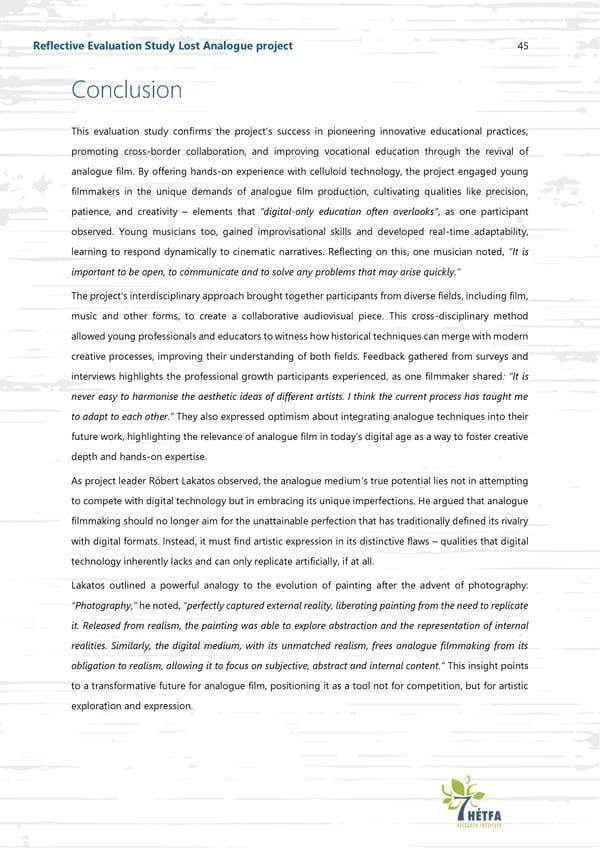45 Reflective Evaluation Study Lost Analogue project C onclus ion This evaluation study confirms the projects success in pioneering innovative educational practices, promoting cross - border collaboration, and improving vocational education through the revival of analogue film. By offering hands - on experience with cellulo id technology, the project engaged young filmmakers in the unique demands of analogue film production, cultivating qualities like precision, patience, and creativity elements that digital - only education often overlooks , as one participant observed. You ng musicians too, gained improvisational skills and developed real - time adaptability, learning to respond dynamically to cinematic narratives. Reflecting on this, one musician noted, It is important to be open, to communicate and to solve any problems that may arise quickly. The projects interdisciplinary approach brought together participants from diverse fields, including film, music and other forms, to create a collaborative audiovisual piece. This cross - disciplinary method allowed young professionals and educators to witness how historical techniques can merge with modern creative processes, improving their understanding of both fields . Feedback gathered from surveys and interviews highlights the professional growth participants experienced, as one filmmaker shared : It is never easy to harmonise the aesthetic ideas of different artists. I think the current process has taught me to adapt to each other. They also expressed optimism about integrating analogue techniques into their future work, highlighting the relevance of analogue film in todays digital age as a way to foster creative depth and hands - on expertise. As project leader Rbert Lakatos observed, the analogue medium s true potential lies not in attempting to compete with digital technology but in embracing its unique imperfections. He argued that analogue filmmaking should no longer aim for the unattainable perfection that has traditionally defined its rivalry with di gital formats. Instead, it must find artistic expression in its distinctive flaws qualities that digital technology inherently lacks and can only replicate artificially, if at all. Lakatos outlined a powerful analogy to the evolution of painting after the advent of photography: Photography, he noted, perfectly captured external reality, liberating painting from the need to replicate it. Released from realism, the painting was able to explore abstraction and the representation of internal realities. Similarly, the digital medium, with its unmatched realism, frees analogue filmmaking from its obligation to realism, allowing it to focus on subjective, abstract and internal content. T his insight points to a transformative future for analogue film, positioning it as a tool not for competition, but for artistic exploration and expression.
 Celluloid Connections: Cultivating creative skills through analogue film and musical collaboration Page 45 Page 47
Celluloid Connections: Cultivating creative skills through analogue film and musical collaboration Page 45 Page 47